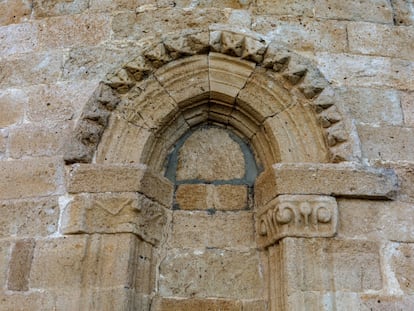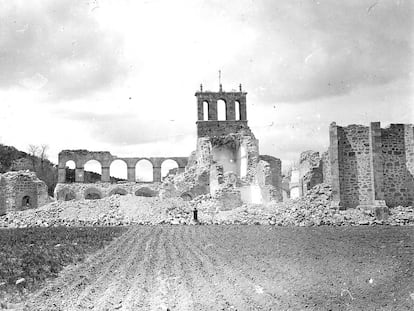The untold story of the high-society ladies who fueled medieval art in Spain’s Basque Country
Researcher Isabel Mellén finds women played more prominent roles than previously thought in the design, sponsorship and management of Romanesque churches
The Middle Ages are widely seen as a parenthesis of darkness between two periods of light; as little more than 1,000 years of subjugation to the recalcitrant power of the Church; as a time when only men could find enough breathing space to get ahead in life; as a period of vice, superstition, ignorance and – as a fetid materialization of all of the above – a flagrant absence of personal hygiene.
Little by little, the degrading stereotypes that have for centuries defined this vast period of history are being exposed for what they are: a deviation from the truth that occasionally borders on the cartoonish. A growing number of contemporary historians are re-reading and retelling the past from a different perspective.
One of these historians is Isabel Mellén, a researcher from Álava province in northern Spain who has been focusing her work on a specific place and time: the area comprising today’s Basque Country between the 11th and the first half of the 13th centuries. One of her conclusions is that the official story ignored the role played by women of the era, for instance with regard to the construction and management of churches built in the Romanesque style that dominated art and architecture at the time.
A teacher at the distance university UNED with a background in philosophy and art history, Mellén is also a researcher for a project called Álava medieval. For the last three years she has been collecting information that is now brought together in a book, Tierra de damas. Las mujeres que construyeron el románico en el País Vasco (or, Land of ladies: The women who built Romanesque art in the Basque Country).
“The issue of women had been going around in my head for a long time,” says the author via a telephone interview from the 11th-century sanctuary of Our Lady of Estíbaliz, a landmark religious building near the Basque city of Vitoria. “I’d already done some research into the convent of San Francisco de Vitoria, which was blown up in 1930. It was a medieval building made by tremendously powerful women who even created a burial site for themselves at the head of the building.”
That research led Mellén to realize that from the 18th century onwards these women, and those who came after them, were simply eliminated from the annals of history, “and I wondered why we had been deceived this way.” Ultimately, she concluded that two major reasons were probably just the weight of tradition and the practice of basing one’s work on other historians’ statements, rather than going directly to the original source. “Re-reading the sources, in this case written in medieval Latin, represents a huge amount of work,” notes Mellén. “There’s this inertia that leads us to fall back on what other people have said before us.”
In her book, the researcher also chips away at other popular notions associated with medieval times, such as that religious powers dominated all aspects of society or that people were sexually repressed. On the contrary, Mellén describes a time of sexual freedom that even extended to members of the clergy and included both heterosexual and homosexual practices.
These and other arguments prop up her main theory: that it was high-society women who promoted and managed many of the Romanesque churches built in today’s Basque Country. What’s more, these were private (and lucrative) buildings erected not so much for pious purposes as to show off the family lineage and build a pantheon to the greater glory and eternal rest of its members. And according to the gender roles of the era, these tasks fell to women.
“I already knew about other cases of female sponsorship of Basque Romanesque architecture, but I found that women’s role was much greater than I had initially imagined,” she explains. In her book, Mellén describes the growing power of the House of Haro, the most powerful Basque lineage of medieval times. There are numerous documents confirming donations made for churches by women of this family, most particularly three: Toda and her daughter María López, and to a lesser degree Ángela Muñoz, the latter’s mother-in-law.
In her new, gender-conscious take on history, Mellén underscores women’s role as the driving force behind church construction, but also their unknown work as artists in their own right. “This idea may seem odd now, but up until the 18th century it was considered quite normal for women to participate in this work,” she notes. And if the 20th-century Basque artist Eduardo Chillida is considered the author of the Comb of the Wind, a landmark set of monumental sculptures in San Sebastián (despite the fact that it was an anonymous workshop that actually built his vision) then why not do the same for the women “who built, used, managed and selected the iconography” for those churches?
Mellén feels that some of her findings could probably be extrapolated to other areas outside the Basque Country, which is “a very good place for this kind of study because, being on the periphery, the nobility ruled without interference,” she explains. This much is evident from the iconography of these churches, where there are barely any representations of religious subject matter, but instead numerous paintings and sculptures representing the local nobility. As a matter of fact, many are ladies’ portraits. There are also male and female genitals, and naked women with snakes, traditionally representing the embodiment of lust and sin.
Mellén believes those images were originally meant to represent concerns and desires over issues such as fertility and childbearing. But they underwent a misogynist interpretation during the Enlightenment, when patriarchal attitudes found favor, she says. “Wealthy women of the 12th century led better lives than our grandmothers, and that is a demonstrable truth,” she says. That is why, she holds, our current interpretation of historical facts says more about who we are than about the way things were back then. “It’s like a distorting mirror that reflects back our own misogyny.”
Tu suscripción se está usando en otro dispositivo
¿Quieres añadir otro usuario a tu suscripción?
Si continúas leyendo en este dispositivo, no se podrá leer en el otro.
FlechaTu suscripción se está usando en otro dispositivo y solo puedes acceder a EL PAÍS desde un dispositivo a la vez.
Si quieres compartir tu cuenta, cambia tu suscripción a la modalidad Premium, así podrás añadir otro usuario. Cada uno accederá con su propia cuenta de email, lo que os permitirá personalizar vuestra experiencia en EL PAÍS.
¿Tienes una suscripción de empresa? Accede aquí para contratar más cuentas.
En el caso de no saber quién está usando tu cuenta, te recomendamos cambiar tu contraseña aquí.
Si decides continuar compartiendo tu cuenta, este mensaje se mostrará en tu dispositivo y en el de la otra persona que está usando tu cuenta de forma indefinida, afectando a tu experiencia de lectura. Puedes consultar aquí los términos y condiciones de la suscripción digital.
More information
Archived In
Últimas noticias
Welcome to the post-religion era: The idea of Christianity as the absolute truth has become obsolete
‘I thought you would like it’: The risky sexual practice popularized by TV shows and TikTok
The digitalization of tourism: ‘They promise experiences and gave us the worst possible one’
Mexican peso defies uncertainty with forecasts of a new period of stability in 2026
Most viewed
- Sinaloa Cartel war is taking its toll on Los Chapitos
- Reinhard Genzel, Nobel laureate in physics: ‘One-minute videos will never give you the truth’
- Oona Chaplin: ‘I told James Cameron that I was living in a treehouse and starting a permaculture project with a friend’
- Why the price of coffee has skyrocketed: from Brazilian plantations to specialty coffee houses
- Silver prices are going crazy: This is what’s fueling the rally











































